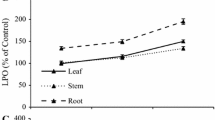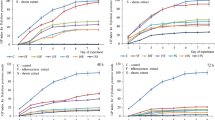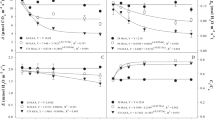Abstract
The tree Acacia dealbata Link is an Australian woody legume that has become a serious environmental problem in Northwest Spain, where its expansion is assumed to reduce populations of native species and threaten local plant biodiversity. In order to investigate the potential involvement of allelopathic mechanisms in this process, net photosynthetic and respiration rates of four test native understory species (Hedera hibernica (G. Kirchn.) Bean, Dicranum sp., Dactylis glomerata L. and Leucobryum sp.) were evaluated using a Clark-type electrode in the presence of canopy leachate collected under A. dealbata stands at four times of the year for 2 years and macerate from their apical branches at the same sites and times. The first two test species were present both inside and outside of A. dealbata stands, while the last two were only located outside the stands. We found that there were significant differences in respiration and net photosynthetic rates between the control and A. dealbata extracts in all test species. The respiration rate was increased by both canopy leachate and macerate extracts on certain collection dates, but net photosynthetic rate was stimulated by macerate and inhibited by canopy leachate on other dates. The main phenological stages of A. dealbata in which respiration and net photosynthetic rates were more affected were blossoming, inflorescence formation and in periods after severe drought, in this decreasing order. Our results also showed that Dicranum sp., Leucobryum sp. and D. glomerata were more affected by aqueous extracts than other species during a 2-year period. We suggest that the observed inhibitory or stimulatory effects on the physiological parameters studied could have an adverse effect on the understory species, and that allelopathic interference seems to participate in this process.


Similar content being viewed by others
References
Abrahim D, Francischini AC, Pergo EM, Kelmer-Bracht AM, Ishii-Iwamoto EL (2003) Effects of α-pinene on the mitochondrial respiration of maize seedlings. Plant Physiol Biochem 41:985–991. doi:10.1016/j.plaphy.2003.07.003
Abrol IP, Yadav JSP, Massoud FI (1988) Salt-affected soils and their management. FAO Soils Bulletin No. 39. Food and Agriculture Organization of the United Nations, Rome
Bais HP, Vepachedu R, Gilroy S, Callaway RM, Vivanco JM (2003) Allelopathy and exotic plant invasion: from molecules and genes to species interactions. Science 301:1377–1380. doi:10.1126/science.1083245
Callaway RM, Aschehoug ET (2000) Invasive plants versus their new and old neighbors: a mechanism for exotic invasion. Science 290:521–523. doi:10.1126/science.290.5491.521
Callaway RM, Ridenour WM, Laboski T, Weir T, Vivanco JM (2005) Natural selection for resistance to the allelopathic effects of invasive plants. J Ecol 93:576–583. doi:10.1111/j.1365-2745.2005.00994.x
Carballeira A, Reigosa MJ (1999) Effects of natural leachates of Acacia dealbata link in Galicia (NW Spain). Bot Bull Acad Sin 40:87–92
Casal JF, Reigosa MJ, Carballeira A (1985) Potentiel allelopathique de Acacia dealbata Link. Rev Ecol Biol Sol 22:1–12
Chou C-H, Fu C-Y, Li S-Y, Wang Y-F (1998) Allelopathic potential of Acacia confusa and related species in Taiwan. J Chem Ecol 24:2131–2150. doi:10.1023/A:1020745928453
Chou SC, Huang CH, Hsu TW, Wu CC, Chou CH (2010) Allelopathic potential of Rhododendron formosanum Hemsl in Taiwan. Allelopath J 25:73–91
Diéguez-Rojo E, González L (2003) Effects of allelochemical 2-benzoxazolinone on growth, pigment content and cell appearance of Tetraselmis suecica (Kylin) Butch. Thalassas 19:13–22
Einhelling FA (2004) Mode of allelochemical action of phenolic compounds. In: Macías FA, Galindo JCG, Molinillo JMG, Cutler HG (eds) Allelopathy chemistry and mode of action of allelochemicals. CRC Press LLC, Boca Raton, FL, pp 217–238
Ens EJ, Bremner JB, French K, Korth J (2009a) Identification of volatile compounds released by roots of an invasive plant, bitou bush (Chrysanthemoides monilifera spp. rotundata), and their inhibition of native seedling growth. Biol Invasions 11:275–287. doi:10.1007/s10530-008-9232-3
Ens EJ, French K, Bremner JB (2009b) Evidence for allelopathy as a mechanism of community composition change by an invasive exotic shrub, Chrysanthemoides monilifera spp. rotundata. Plant Soil 316:125–137. doi:10.1007/s11104-008-9765-3
Ens EJ, French K, Bremner JB, Korth J (2010) Novel technique shows different hydrophobic chemical signatures of exotic and indigenous plant soils with similar effects of extracts on indigenous species seedling growth. Plant Soil 326:403–414. doi:10.1007/s11104-009-0021-2
Fernandez C, Lelong B, Vila B, Mévy JP, Robles C, Greff S, Dupouyet S, Bousquet-Mélou A (2006) Potential allelopathic effect of Pinus halapensis in the secondary succession: an experimental approach. Chemoecology 16:97–105. doi:10.1007/s00049-006-0334-z
Flexas J, Galmes J, Ribas-Carbo M, Medrano H (2005) The effects of water stress on plant respiration. In: Lambers H, Ribas-Carbó M (eds) Plant respiration. Springer, The Netherlands, pp 85–94
González L (2004) Relaciones alelopáticas. In: Reigosa MJ, Pedrol N, Sanchez A (eds) La ecofisiología vegetal una ciencia de síntesis. Thomson, Madrid, pp 527–576
González L, Souto XC, Reigosa MJ (1995) Allelopathic effects of Acacia melanoxylon R.Br. phyllodes during their decomposition. For Ecol Manag 77:53–63. doi: 10.1016/0378-1127(95)03581-T
Guar JP, Singh AK (1990) Growth, photosynthesis and nitrogen fixation of Anabaena doliolum exposed to Assam crude extract. Bull Environ Contam Toxicol 44:494–500. doi:10.1007/BF01701235
Han C-M, Pan K-W, Wu N, Wang J-C, Li W (2008) Allelopathic effect of ginger on seed germination and seedling growth of soybean and chive. Sci Hortic 116:330–336. doi:10.1016/j.scienta.2008.01.005
Ishii-Iwamoto EL, Abrahim D, Sert MA, Bonato CM, Kelmer-Bracht AM, Bracht A (2006) Mitochondria as a site of allelochemical action. In: Reigosa MJ, Pedrol N, González L (eds) Allelopathy: a physiological process with ecological implications. Springer, The Netherlands, pp 267–284
Kato-Noguchi H (2003) Allelopathic potential of Pueraria thunbergiana. Biol Plant 47:471–473. doi:10.1023/B:BIOP.0000023899.52362.f3
Keane RM, Crawley MJ (2002) Exotic plant invasions and the enemy release hypothesis. Trends Ecol Evol 17:164–170. doi:10.1016/S0169-5347(02)02499-0
Lorenzo P (2010) Invasion of Acacia dealbata Link: new perspectives on allelopathic process. PhD dissertation, University of Vigo, Vigo
Lorenzo P, Pazos-Malvido E, González L, Reigosa MJ (2008) Allelopathic interference of invasive Acacia dealbata: physiological effects. Allelopath J 22:452–462
Lorenzo P, González L, Reigosa MJ (2010) The genus Acacia as invader: the characteristic case of Acacia dealbata Link in Europe. Ann For Sci 67:101. doi:10.1051/forest/2009082
Martínez-Otero A, González L (2005) Oxygen electrode for seedling metabolism measurements in allelopathy. Allelopath J 16:95–104
Mersie M, Singh M (1987) Allelopathic effect of parthenium (Parthenium hysterophorus L.) extract and residue on some agronomic crops and weeds. J Chem Ecol 13:1739–1747. doi:10.1007/BF00980214
Pedrol N, González L, Reigosa MJ (2006) Allelopathy and abiotic stress. In: Reigosa MJ, Pedrol N, González L (eds) Allelopathy: a physiological process with ecological implications. Springer, The Netherlands, pp 171–209
Rafiqul Hoque ATM, Ahmed R, Uddin MB, Hossain MK (2003) Allelopathic effect of different concentration of water extracts of Acacia auriculiformis leaf on some initial growth parameters of five common agricultural crops. Pak J Agron 2:92–100
Reigosa MJ (1987) Estudio del potencial alelopático de Acacia dealbata Link. PhD dissertation, University of Santiago, Santiago de Compostela
Reigosa MJ, González L (2006) Forest ecosystem and allelopathy. In: Reigosa MJ, Pedrol N, González L (eds) Allelopathy: a physiological process with ecological implications. Springer, The Netherlands, pp 451–463
Reigosa MJ, Casal JF, Carballeira A (1984) Efectos alelopáticos de Acacia dealbata Link durante su floración. Stud Oecologia V:135–150
Reigosa MJ, Souto XC, González L (1999) Effect of phenolic compounds on the germination of six weeds species. Plant Growth Regul 28:83–88. doi:10.1023/A:1006269716762
Reigosa MJ, Pedrol N, Sánchez-Moreiras AM, González L (2002) Stress and allelopathy. In: Reigosa MJ, Pedrol N (eds) Allelopathy: from molecules to ecosystems. Science Publishers Inc, Playmouth, pp 231–256
Rice EL (1984) Allelopathy. Academic Press, Orlando
Rose SL, Perry DA, Pilz D, Schoeneberger MM (1983) Allelopathic effects of litter on the growth and colonization of mycorrhizal fungi. J Chem Ecol 9:1153–1162. doi:10.1007/BF00982218
Seigler DS (2003) Phytochemistry of Acacia—sensu lato. Biochem Syst Ecol 31:845–873. doi:10.1016/S0305-1978(03)00082-6
Sinkkonen A (2006) Ecological relationships and allelopathy. In: Reigosa MJ, Pedrol N, González L (eds) Allelopathy: a physiological process with ecological implications. Springer, The Netherlands, pp 373–393
Sodaeizadeh H, Rafieiolhossaini M, Havlík J, Van Damme P (2009) Allelopathic activity of different plant parts of Peganum harmala L. and identification of their growth inhibitors substances. Plant Growth Regul 59:227–236. doi:10.1007/s10725-009-9408-6
Sokal RR, Rohlf FJ (1995) Biometry. The principles and practice of statistics in biological research. Freeman, New York
Thelen GC, Vivanco JM, Newingham B, Good W, Bais HP, Landres P, Caesar A, Callaway RM (2005) Insect herbivory stimulates allelopathic exudation by an invasive plant and the suppression of natives. Ecol Lett 8:209–217. doi:10.1111/j.1461-0248.2004.00713.x
Wang W, Gorsuch JW, Hughes JS (1997) Plants for environmental studies. CRC Lewis Publishers, Boca Raton
Weir TL, Park S-W, Vivanco JM (2004) Biochemical and physiological mechanisms mediated by allelochemicals. Current Opin Plant Biol 7:472–479. doi:10.1016/j.pbi.2004.05.007
MeteoGalicia. Consellería de Medio Ambiente, Territorio e Infraestruturas. Xunta de Galicia. http://www.meteogalicia.es
Zhou YH, Yu JQ (2006) Allelochemicals and photosynthesis. In: Reigosa MJ, Pedrol N, González L (eds) Allelopathy: a physiological process with ecological implications. Springer, The Netherlands, pp 127–139
Acknowledgments
We are especially grateful for the contribution of the three anonymous reviewers who, with their comments, have enriched and improved the original manuscript. We would like to thank the Xunta de Galicia for funding the project “Estudio del componente alelopático en la capacidad invasiva de la mimosa (Acacia dealbata Link) en el bosque y las plantaciones forestales gallegas” PGIDIT05RAG31001PR and the project “Estudio da capacidade invasora de Acacia dealbata: mecanismos de control integrados e sustentabilidade” 08MDS033310PR. We would also like to thank the Consellería de Innovación e Industria and Universidade de Vigo for the PhD grant of Paula Lorenzo and the collaboration grant of Ana Palomera-Pérez.
Author information
Authors and Affiliations
Corresponding author
Rights and permissions
About this article
Cite this article
Lorenzo, P., Palomera-Pérez, A., Reigosa, M.J. et al. Allelopathic interference of invasive Acacia dealbata Link on the physiological parameters of native understory species. Plant Ecol 212, 403–412 (2011). https://doi.org/10.1007/s11258-010-9831-9
Received:
Accepted:
Published:
Issue Date:
DOI: https://doi.org/10.1007/s11258-010-9831-9




